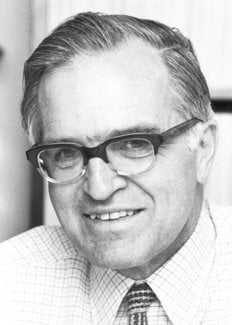Aage N. Bohr
Biographical

I was born in Copenhagen on June 19, 1922, as the fourth son of Niels Bohr and Margrethe Bohr (née Nørlund). During my early childhood, my parents lived at the Institute for Theoretical Physics (now the Niels Bohr Institute), and the remarkable generation of scientists who came to join my father in his work became for us children Uncle Kramers, Uncle Klein, Uncle Nishina, Uncle Heisenberg, Uncle Pauli, etc. When I was about ten years old, my parents moved to the mansion at Carlsberg, where they were hosts for widening circles of scholars, artists, and persons in public life.
I went to school for twelve years at Sortedam Gymnasium (H. Adler’s fæellesskole) and am indebted to many of my teachers, both in the humanities and in the sciences, for inspiration and encouragement.
I began studying physics at the University of Copenhagen in 1940 (a few months after the German occupation of Denmark). By that time, I had already begun to assist my father with correspondence, with his writing of articles of a general epistemological character, and gradually also in connection with his work in physics. In those years, he was concerned partly with problems of nuclear physics and partly with problems relating to the penetration of atomic particles through matter.
In October 1943, my father had to flee Denmark to avoid arrest by the Nazis, and the whole family managed to escape to Sweden, where we were warmly received. Shortly afterwards, my father proceeded to England, and I followed after him. He became associated with the atomic energy project and, during the two years until we returned to Denmark, in August 1945, we travelled together spending extensive periods in London, Washington, and Los Alamos. I was acting as his assistant and secretary and had the opportunity daily to share in his work and thoughts. We were members of the British team, and my official position was that of a junior scientific officer employed by the Department of Scientific and Industrial Research in London. In another context, I have attempted to describe some of the events of those years and my father’s efforts relating to the prospects raised by the atomic weapons1.
On my return to Denmark, I resumed my studies at the University and obtained a master’s degree in 1946. My thesis was concerned with some aspects of atomic stopping problems.
For the spring term of 1948, I was a member of the Institute for Advanced Study in Princeton. On a visit during that period to Columbia University and through discussions with professor I.I. Rabi, I became interested in a newly discovered effect in the hyperfine structure in deuterium. This led on to my association with Columbia University from January 1949 to August 1950. As described in my lecture, this was for me a very fruitful association.
Soon after my return to Copenhagen, I began the close cooperation with Ben Mottelson which has continued ever since. The main direction of our work is described in the lectures included in the present volume. During the last fifteen years, a major part of our efforts has been connected with the attempt to present the status of our understanding of nuclear structure in a monograph, of which Volume I (Single-Particle Motion) appeared in 1969, and Volume II (Nuclear Deformations) in 1975. We feel that in our cooperation, we have been able to exploit possibilities that lie in a dialogue between kindred spirits that have been attuned through a long period of common experience and jointly developed understanding. It has been our good fortune to work closely together with colleagues at the Niels Bohr Institute and Nordita, including the many outstanding scientists who have come from all parts of the world and have so greatly enriched the scientific atmosphere and personal contacts.
I have been connected with the Niels Bohr Institute since the completion of my university studies, first as a research fellow and from 1956 as a professor of physics at the University of Copenhagen. After the death of my father in 1962, I followed him as director of the Institute until 1970.
For our whole circle, it has been a challenge to exploit the opportunities provided by the traditions of the Institute, of which I would like especially to mention two aspects. One concerns the fruitful interplay between experimental and theoretical investigations. The other concerns the promotion of international cooperation as a vital factor in the development of science itself and also as a means to strengthen the mutual knowledge and understanding between nations.
In 1957, Nordita (Nordisk Institut for Teoretisk Atomfysik) was founded on the premises of the Niels Bohr Institute, and the two institutes operate in close association. I have been a member of the Board of Nordita from 1957 until 1975, and since then director of this institute.
In March 1950, in New York City, I was married to Marietta Soffer. We have three children, Vilhelm, Tomas, and Margrethe. Both for my wife and myself, the personal friendships that have grown out of scientific contacts with colleagues from many different countries have been an important part of our lives, and the travels we have made together in connection with the world-wide scientific co-operation have given us rich treasures of experiences.
1. Niels Bohr. His life and work as seen by his friends and colleagues, p. 191. Ed. by S. Rozental, North-Holland Publishing Company, Amsterdam 1967.
This autobiography/biography was written at the time of the award and later published in the book series Les Prix Nobel/ Nobel Lectures/The Nobel Prizes. The information is sometimes updated with an addendum submitted by the Laureate.
Aage N. Bohr died on 8 September, 2009.
Nobel Prizes and laureates
Six prizes were awarded for achievements that have conferred the greatest benefit to humankind. The 14 laureates' work and discoveries range from quantum tunnelling to promoting democratic rights.
See them all presented here.
